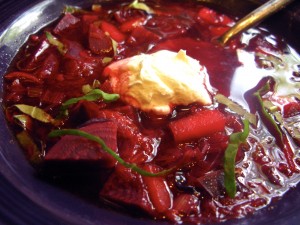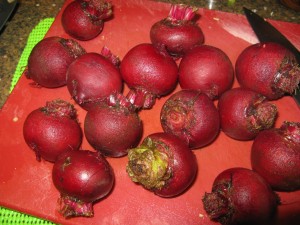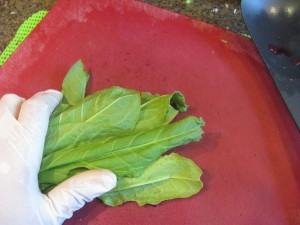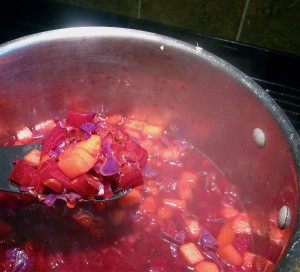We Got The Beets: Ginger-Kissed Borscht
Yeah, we got the beets!
Sorry, that old Go-Gos song gets stuck in my head, especially when I’m scrubbing a couple of pounds of beets to make borscht. See, I never peel my beets–lots of the nutrients are right under the skin, and besides, they are a pain in the tuckus to peel, so I just scrub the daylights out of them with a vegetable brush under cold running water. And invariably, while I’m scrubbing, a tinny, ghostly sound ripples through my psyche, slithering through my neurons, wending its serpentine way through the halls of my high school memories before gripping my cerebrum tightly in its manicured talons, shaking it and refusing to let go.
It’s the unforgettable opening drum solo joined by the driving guitar riff, then finally, Belinda Carlisle’s vocals, and dammit–there it is again, and it’s stuck in my head for at least the rest of the day. “We Got the Beat” is then going to play over and over on Barbara’s Brain Radio station accompanied by visuals of bouncing magenta root vegetables dressed in glitter and go go boots until displaced by another, equally annoyingly catchy tune, such as Leonard Nimoy’s “The Ballad of Bilbo Baggins.”
And now that I’ve mentioned the dreaded song, “The Ballad of Bilbo Baggins,” can anyone tell me just how high Nimoy was when he recorded not just the song, but the video? I mean, Nimoy was always ahead of his time and all, but why record a video when MTV hadn’t even been invented yet? And, why -THAT- video? Don’t get me wrong, I me some Leonard Nimoy, not just because he gave the world my beloved Spock who was my role model during my troubled teen years, but also because he’s a talented poet, artist and director and a really cool guy, but Bilbo? Really?
Alas, I digress.
We were talking about beets, not hobbits.
Beets. I don’t hate them anymore, in fact, I rather like them. When I was a child, I only valued them because they dyed my hands pink and they were a pretty color, but I wouldn’t eat them even if I was paid to do it. Now, I like them because they are a gorgeous color, and I love the taste and smell of them, but I’m not so into pink hands, so I wear latex gloves when handling them. I guess I’ve grown up a bit, eh? Oh, well.
But, I have to say, remembering my childhood fascination with the color of beets is useful, because I used that knowledge to get Kat to taste them. I told her she could use a piece of roasted beet to tint her lips pink, like lipstick. She did it! Then I had her lick her lips and she liked the way they tasted, so she tasted the beet and then–ATE IT! Ha ha! Point one for the clever Mommy who remembered how important things like colors are in childhood! And–she liked it! Because I told her it was sweet–which it was–and didn’t tell her that only grownups liked beets–which is what my mother told me when I was little. (Self-fulfilling prophesy there.)
Beets are now on the menu at my house, and usually, I serve them roasted, because that’s how all of us like them, but sometimes I get a craving for a good bowl of steaming hot borscht. (Unless its summer, and then I want it cold.) In the winter, I like it with beef or sausage in it, but in the spring and summer, I prefer it made vegetarian, though not vegan, because to eat it without a good dollop of Greek yogurt in the middle is like seeing Dolly Parton without sequins. It’s just as pretty and sweet, but something is missing and that’s the glitz that makes it all so special.
Now last week, when I made this borscht, I had an awful cold. Terrible. I won’t describe all of the soggy details, but let it suffice to say that my sense of smell was a bit off and my throat hurt like the dickens and i desperately wanted something warm, comforting and tasty soothe the savage tonsils and make my cold innards thaw out. And so, I had all these beets, and some pretty red cabbage and some Gold Rush apples, all local, in the fridge and I thought–aha! Borscht! But then I got sad because the flavors of borscht are pretty mild, and without a lot of flavor, any soup was going to taste like lumpy hot water to my virus-deadened senses. No fun.
But then, I thought to myself, “Why not add fresh ginger to the soup? And star anise, and maybe a bit of cinnamon and fennel?” After digging in the fridge, I came up with a stalk of lemongrass. A plan began to formulate in my head and I slogged off to the computer to check a vague memory I had of a Chinese version of borscht.
I was right. I -had- remembered reading about a Chinese variant of borscht, though it is made with tomatoes and not beets. Or red cabbage and no beets. Apparently, it is popular in the northern city of Harbin, and the direct translation of its name is, “red soup.” It is also known in Hong Kong as well.
But, I had beets, and I didn’t want to use beef, so I decided to make up my own version of Borscht with Chinese spices and flavorings and to heck with what’s traditional anywhere else in the world.
So, I did.
And, I’m glad I did, because this is my favorite version of borscht yet.
The Chinese flavorings melded perfectly with the sweet earthiness of the beets and the tang of the lemon juice. The apples took to the spices readily and the perfume of lemongrass made a light, floral note that made the soup taste like the essence of springtime.
A final fresh note graced the soup in the form of the chiffonade of fresh sorrel leaves I sprinkled over the top as a garnish. Sorrel isn’t as commonly grown in the US as it should be–it’s a light, brightly flavored garden green whose broad, long leaves are tangy with oxalic acid, which in small amounts is harmless to beneficial–in large amounts it is poisonous and can be fatal. However, it is widely used in European cuisines–sorrel soup is a famous green pureed soup in France, and in Greece, it is used with spinach, mint and other wild greens in spanakopita, which is a delectable phyllo dough triangle-shaped pastry with cheese.
This is a very tasty soup and very quick and easy to make for a good spring lunch or first course for dinner. It is filled with vegetative goodness: garlic leeks (or leeks) celery, carrots, beets, apples and cabbage, and has lots of aromatics to help make everything taste like a sunny spring day: fresh ginger, lemongrass, star anise, cinnamon, fennel seeds, lemon juice and sorrel.
This soup also freezes well, and is good to have around in case a cold or a beet emergency–meaning–a sudden middle of the night craving for beets. I’m sure it happens to someone, though maybe not as often as a chocolate doughnut or cheesecake emergency.
Ginger-Kissed Borscht
Ingredients:
3 garlic leeks or regular leeks (if using regular leeks, add 3 cloves of garlic, minced to the recipe)
2 tablespoons olive oil
3 stalks of celery, sliced thinly
3 carrots, peeled or scrubbed well and thinly sliced
2 ” cube fresh ginger, peeled and minced
1 stalk lemongrass, lower third only, crushed lightly
1 star anise
1″ piece cinnamon stick
1/4 teaspoon fennel seeds, ground (I did mine fresh in the mortar and pestle)
2 quarts vegetable broth or stock
1 heaping tablespoon honey
2 1/2 pounds red beets, well scrubbed, tops and bottoms trimmed away
2 tart apples
2 cups finely shredded red cabbage (use a knife to shred into thin strips–like chiffonade)
Juice of 1 or 2 large lemons–to taste
1″ cube fresh ginger peeled and grated– add to taste
salt to taste
pepper to taste
fresh sorrel or parsley for garnish
Greek yogurt for serving
Method:
Cut the coarse, dark green leaves from the tops of the garlic leeks and discard (in the compost pile, preferably.) Slice the garlic leeks longitudinally in half and rinse well under cold water, using your fingers to work under all the layers of the vegetable. Dry well on paper towels or cotton woven towels. Slice thinly after they are dry.
Over a medium fire, heat olive oil in a heavy-bottomed soup pot and add garlic leeks (or leeks and minced garlic), celery, carrots and ginger, and cook, stirring, until the leeks and celery take on a golden coloration and all is very fragrant. Add the lemongrass stalk, star anise, cinnamon, and fennel and cook, stirring for one more minute.
Add vegetable broth and honey and bring to a simmer.
Dice the beets into a fine, but not tiny dice–about 1/2″ on all sides, and add to the pot. Peel the apples and add them when the beets are halfway cooked. After shredding the cabbage, cut the shreds into 1″ lengths and add to the soup after the beets are done. During the cooking, add water or more broth if necessary.
Simmer for 1/2 hour more after the beets are fully tender. Turn off heat, add lemon juice, freshly grated ginger, salt and pepper to taste.
Sprinkle each bowl with chiffonade cut sorrel leaves or minced parsley leaves, and pass Greek yogurt for each diner to add to their own taste.
6 Comments
RSS feed for comments on this post.
Sorry, the comment form is closed at this time.
Powered by WordPress. Graphics by Zak Kramer.
Design update by Daniel Trout.
Entries and comments feeds.







That’s interesting that the Chinese version is popular in Harbin – My mother’s parents, who were Russian, lived in Harbin in the early 20th Century, and there was a HUGE Russian community there, all folks who had fled the Bolshevick revolution. I wouldn’t be surprised if the Russian influence is what made that particular dish happen. My mother also grew up eating Chinese food, and we always had an interesting mix of international goods on the dinnertable when I was growing up.
Comment by Maria in Oregon — May 23, 2011 #
As I understand it, Maria, there was always a great deal of trade between China and Russia, and the center of that trade was in Harbin, China. That’s probably where the Russian community started and then after the revolution, it just got bigger. But, yes, that is the explanation for the Chinese version of borscht. It’s so cool that your grandparents lived there!
Comment by Barbara — May 23, 2011 #
Glad to know I’m not the only person who knows the bizarre horror that is “The Ballad of Bilbo Baggins!” A lot of people know about William Shatner’s “Rocket Man,” but not as many are familiar with that one.
I loved beets as a kid, because they were sweet. I still love them!
Comment by Laura B. — May 24, 2011 #
Laura–“Bilbo” can usually chase any song that has been put on repeat on my brain radio out of my ears. But then, it installs itself on brain radio and refuses to be dislodged by anything less than the old Meow Mix commercial song.
I once spent a hellish week in teenhood with that horrific jingle stuck in my head. The only reason I didn’t stick an icepick in my ears is because I knew it wouldn’t go away even then. What dislodged that?
The theme from “Gilligan’s Island.”
The DJ that runs my brain radio station is a sadistic green gnome from the planet “Let’s Drive Barbara Slowly Crazy.” I call him Sid. We now have a detente which means we mostly leave each other alone.
However, I have learned that there is a way to shut Sid up. Listen to Yma Sumac. That will do it. He runs from her in terror.
Comment by Barbara — May 24, 2011 #
Barbara,
Wow, I’m glad to see you’re back! I’d stopped checking the site except that I just got at Preethi grinder as a birthday present, and then I noticed that you had new posts.
That’s like *two* birthday presents. Welcome back!
Comment by Fuzzy Chef — May 25, 2011 #
Thanks, Fuzzy! My Preethi is still going strong, helping me make Indian food at least twice a week, more on most weeks.
Love it. You will love yours too, I am sure of it.
Comment by Barbara — May 25, 2011 #